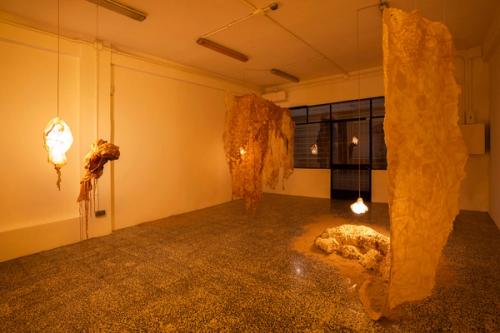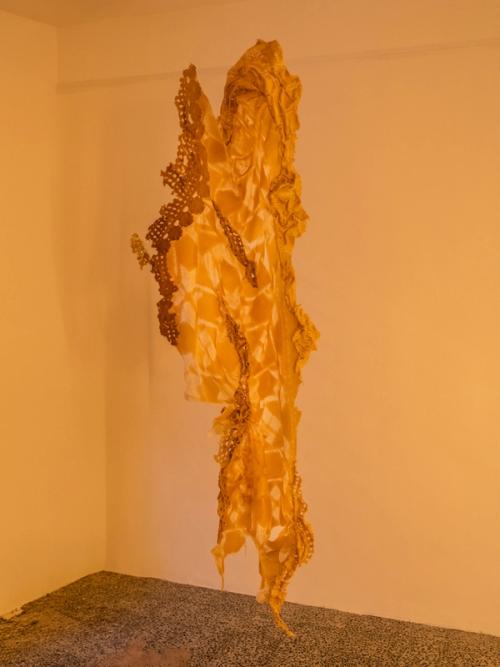Desde dentro, parece que brota algo
Solo show by Maya Pita-Romero
Desde dentro, parece que brota algo
Solo show by Maya Pita-Romero
18 January - 23 February 2024
credits
Goro Studio
Maya Pita-Romero's practice aligns with what could be called a post-natural conviction. Maya is part of a generation that has grown up and developed interests within the technological revolution, which caused a rift not only in the visual arts but essentially in everything around us. Slowly, a kind of tradition has formed, composed of practices that not only deepen into the present but also explore future possibilities: what will our lives be like in the short and medium term?
We find Maya's work particularly interesting due to the combination of traditional elements with the conceptual possibilities of a generation that takes for granted the end of the era of homo sapiens as the primary agent of ecosystems, yet explores from a strictly corporeal perspective. On the other hand, we are intrigued by the risk of moving away from the canonically beautiful to delve more deeply into what art can mean beyond the decorative and/or aesthetic; if we are no longer the center of the universe, what lies beyond the art we produced as such? In Maya's work, we could equate the aesthetic with the static, and in response to that dichotomy, she has created dynamic bifurcations that change according to materials, space, and even living elements that compose some of the works – such as ferments or blood. In this way, the work mutates and definitively detaches itself from the artist's body, creating its own ecosystem, which is not impermeable and can react to others around it.
We are interested in approaching Maya's work from the question, "What is art?" and, in this particular case, it also leads us to "What is the purpose of art?" As mentioned, the post-natural conviction is one that is still in development, and our most sensible connection to the theses developed in Maya's works comes from a generational intersection: we understand that art is not content to be a sterile reflection of its surroundings but has taken on an active quality that serves as cohesion and understanding among our different generations. However, we also appreciate the aesthetic quality left to us by the artistic tradition until the end of the last century; the connection to Maya's work serves as a bridge between two lands, one of art that broadens and another that anchors. Similarly, the artist looks to a past that is not her own but that of her ancestors to understand how we, as humanity, have arrived at this moment, extrapolating from her closest ecosystem (family) and highlighting the importance of the care we owe to ourselves, which may be what saves us from the unknown abyss after ceasing to be the center of the universe. The sculptures we see confront us with the unpleasant, constructed from the tenderness and the ancestral nature of the mother bed (and matriarchy), because through artistic practice, we can understand that humanity (pre or post-natural) is a set of interchangeable dualities; thus, birth means pain, the ability to bear means blood, creation means death, and all these elements are reversible to a considerable infinity.
In a way, the evolution of Maya's practice serves as a guide to traverse various evolutions: human, artistic, natural. The conceptual nature of a possible future continues to intertwine with the fundamental aspects of form in art in a constant and endless fabric, like the blankets woven by her great-grandmother that have served to cover different generations and now, in the hands of the artist, transform into a different type of attire, one that pushes us to think about the past and the future, from our current position and with everything we have experienced. What is the use of art if not for this?
We find Maya's work particularly interesting due to the combination of traditional elements with the conceptual possibilities of a generation that takes for granted the end of the era of homo sapiens as the primary agent of ecosystems, yet explores from a strictly corporeal perspective. On the other hand, we are intrigued by the risk of moving away from the canonically beautiful to delve more deeply into what art can mean beyond the decorative and/or aesthetic; if we are no longer the center of the universe, what lies beyond the art we produced as such? In Maya's work, we could equate the aesthetic with the static, and in response to that dichotomy, she has created dynamic bifurcations that change according to materials, space, and even living elements that compose some of the works – such as ferments or blood. In this way, the work mutates and definitively detaches itself from the artist's body, creating its own ecosystem, which is not impermeable and can react to others around it.
We are interested in approaching Maya's work from the question, "What is art?" and, in this particular case, it also leads us to "What is the purpose of art?" As mentioned, the post-natural conviction is one that is still in development, and our most sensible connection to the theses developed in Maya's works comes from a generational intersection: we understand that art is not content to be a sterile reflection of its surroundings but has taken on an active quality that serves as cohesion and understanding among our different generations. However, we also appreciate the aesthetic quality left to us by the artistic tradition until the end of the last century; the connection to Maya's work serves as a bridge between two lands, one of art that broadens and another that anchors. Similarly, the artist looks to a past that is not her own but that of her ancestors to understand how we, as humanity, have arrived at this moment, extrapolating from her closest ecosystem (family) and highlighting the importance of the care we owe to ourselves, which may be what saves us from the unknown abyss after ceasing to be the center of the universe. The sculptures we see confront us with the unpleasant, constructed from the tenderness and the ancestral nature of the mother bed (and matriarchy), because through artistic practice, we can understand that humanity (pre or post-natural) is a set of interchangeable dualities; thus, birth means pain, the ability to bear means blood, creation means death, and all these elements are reversible to a considerable infinity.
In a way, the evolution of Maya's practice serves as a guide to traverse various evolutions: human, artistic, natural. The conceptual nature of a possible future continues to intertwine with the fundamental aspects of form in art in a constant and endless fabric, like the blankets woven by her great-grandmother that have served to cover different generations and now, in the hands of the artist, transform into a different type of attire, one that pushes us to think about the past and the future, from our current position and with everything we have experienced. What is the use of art if not for this?














